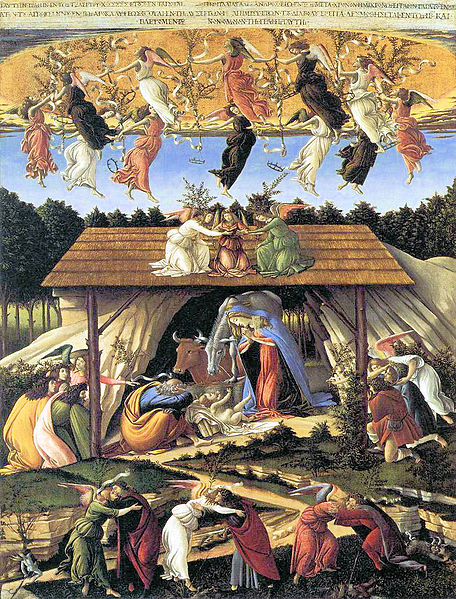| The Mystical Nativity | |
|---|---|
 |
|
| Artist | Botticelli |
| Year | c. 1500–1501 |
| Medium | Oil on canvas |
| Location | National Gallery of London, UK |
| Dimensions | 42.7 in × 29.5 in |
| 108.5 cm × 74.9 cm | |
| Famous Paintings by Botticelli | |
| Fortitude | |
| Adoration of the Magi | |
| The Birth of Venus | |
| Primavera | |
| Cestello Annunciation | |
| Saint Augustine | |
| Venus and Mars | |
| The Mystical Nativity | |
| Temptations of Christ | |
| Complete Works |
A master of Italian Renaissance art, Alessandro di Mariano di Vanni Fillipepi, better known as Sandro Botticelli created the The Mystical Nativity in 1500-1501. Botticelli apprenticed as a goldsmith at the age of fourteen, for his brother Antonio initially. In 1462, he became an apprentice to Fra Filippo Lippi, an Italian painter, where he learned painting techniques in a more intimate and detailed manner. By 1470, Sandro had his own art workshop. His works are mostly characterized by clear contours of figures, and few strong contrasts of light and shadow. The Mystical Nativity is his only work in which he signed.
Creative Influences
Girolamo Savonarola was a rebellious Italian Dominican friar and preacher, who wanted to reform religion in Florence. After the Medici’s had been overthrown in Florence, Savonarola took control in 1494. He professed that everything associated with moral weakness, including the finest Florentine Renaissance artwork, should be burned. Botticelli was not only subjected to Savonarola’s preachings, but was also intrigued. Pope Alexander VI excommunicated Savonarola in 1497, and he was hung and burned. Although it is not known if Botticelli was a follower of Savonarola’s, it is thought that Savonarola had a great influence on his Mystical Nativity composition.
Mysterious Symbolism
Botticelli began painting the Mystical Nativity just a few days after Savonarola’s famous Lenten sermon. Savonarola’s message was to repent, distance yourself from demons and let the angels take you to the Savior. This became the basic theme of Mystical Nativity. The inscription at the top of the painting indicates that Botticelli believed himself to be living in the final period before the second coming of Christ. This could be from the enormous upheavals in Europe’s religious and political realms, as well as Savonarola’s messages.
Mystical Nativity in a general view is one of the nativity scene, with Mary, Joseph, baby Jesus, angels, and animals. If you look closely, to detail, symbolic and unusual iconography or interpretation of composition images can be made. Each of the symbolic interpretations relate back to the context of Savonarola’s sermons.
The circle of twelve angels at the top of the painting represent the twelve hours in a day, and the twelve months of the year. The angels represent faith, hope, and charity, dressed in the corresponding white, red, and green robes. The angels are pulling people out of a state of religious limbo, saving them from the demons. The words on the angels ribbons, which cannot be seen except with infrared refletography, shows that the words correspond to the twelve privileges of the Virgin.
At the bottom of the painting, seven demons are trying to escape under flagstone, fleeing to the underworld. Some are impaled on their own weapons. These demonic creatures are located at the bottom, where angels are embracing the gentiles, saving them from their own demons, causing the demons to flee. The largest figures are of Mary and Joseph, emphasizing good over evil.
Additional Interesting Facts
Botticelli used oil paints on canvas, instead of wood for this painting. To create the heavenly dome in which the twelve angels are circling, he used the goldsmith’s craft which he learned as a boy, using gold flecked paint. He used gold to create an untarnished heaven, knowing that gold does not darken or decay over time like silver does. Botticelli used canvas, as opposed to wood for this painting, because canvas could be rolled and hidden. The Mystical Nativity was hidden for over three centuries after Botticelli’s death in 1510, and was brought to public attention by a British art collector who purchased the painting.